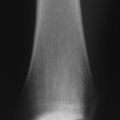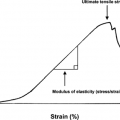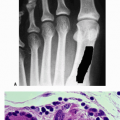Familial Adenomatous Polyposis
Kathryn Palomino
Familial adenomatous polyposis (FAP) is characterized by early onset of multiple colorectal polyps. These polyps are premaligmant lesions that are highly likely to progress into carcinomas. Its orthopaedic importance lies in the association of osteomas with FAP and in the fact that Gardner syndrome, previously considered a distinctly different entity, is now considered to be a subset of FAP in which patients, in addition to having polyps, may develop osteomas, epidermoid cysts, desmoid tumors, and dental abnormalities.
Pathogenesis
Etiology
Genetic defect for both FAP and Gardner syndrome: mutation of the adenomatous polyposis coli (APC) gene (5q21-22 region)
Creates premature stop codon resulting in production of a truncated nonfunctioning protein
Inheritance: autosomal dominant with high but variable penetrance
De novo mutations: 10% to 20% of cases
Phenotype varies by mutation site.
Epidemiology
Incidence: 1 in 8,000 to 1 in 10,000 people
Accounts for 1% of all cases of colorectal cancer
Pathophysiology
Gene for FAP has been cloned, but function is unknown, as is the biological basis of the syndrome.
Abnormalities in colonic epithelium and skin fibroblasts are present.
Classification
Classic FAP
Polyps (Fig. 7.1-1)
Colonic and duodenal adenomas
Gastric fundic hyperplasia
Jejunal and ileal adenomas
Ileal lymphoid polyps
Extraintestinal lesions
Mandibular osteomas
Dental abnormalities
Gardner variant








